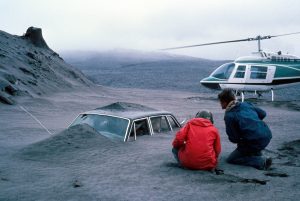Geologist Recalls Mount St. Helens Eruption 37 Years Ago
The morning of May 18, 1980, was warm and sunny in southwestern Washington. At 8:32 a.m., I was in the room with seismographs that had been established in the Forest Service building in Vancouver, 45 miles southwest of the volcano. Suddenly, needles on the seismographs wiggled furiously.

USGS geologist Don Swanson (in red) and his colleague, Jim Moore, view a car filled with ash deposits from the May 18, 1980, eruption of Mount St. Helens.
A startled colleague and I watched in amazement as the shaking continued. We realized that something catastrophic was happening at Mount St. Helens. I ran upstairs to radio David Johnston, a friend and colleague who was at an observation post (Coldwater 2) 6 miles north of the volcano. Receiving no answer, I raced back downstairs. Though the shaking continued, no one could see the volcano from the building.
The Forest Service ordered a fire-spotter plane to investigate. About 30 minutes later, when it left Vancouver, I was aboard. A gray columnar cloud towered above a Mount St. Helens that had lost its top, no longer rising gracefully to a peak like Mount Fuji.
The plane reached the south side of the volcano but, because of ash in the air, couldn’t go farther north. Flying east and west for the next three hours, we observed, photographed, and wondered.
We had glimpses into the deep crater, around which the upper slope of the volcano was now only a shell. Radio messages told us of mudflows down the Toutle River valley that were threatening the I-5 bridge, but we could see nothing in the valley.
Nearly half a mile wide, the column of ash and volcanic gas rose from the crater to a height of more than 80,000 ft. The margin of the column was made of bulbous cells that convected internally while rising with the column. Within the column, lightning flashed.
Eerily, above the droning of the plane’s two engines, we heard nothing from the eruption—like watching a silent movie. Every so often, we saw small flows of ash over-top the crater rim and start down the south flank before stopping.
Around noon, the ash column, which had been gray, assumed a darker color. Its intensity increased and was almost frightening to us in the plane. Looking over the west crater rim, we saw pyroclastic flows moving northward onto what became known as the Pumice Plain.
Low on fuel, we returned to Vancouver around 12:45 p.m. I was replaced by another observer and returned to the Forest Service building, certain that David Johnston had perished.
Sometime in mid-afternoon, I debriefed Harry Glicken, a young geologist who had manned Coldwater 2, where Dave spent his final night. Harry had managed to get a seat on a search-and-rescue helicopter that wended its way up the North Fork Toutle valley. He noticed that the valley was floored by a hummocky debris avalanche deposit. (Harry eventually wrote his Ph.D. dissertation about the avalanche, showing that it formed when the upper north flank of the volcano slid away, opening the crater.)
The changed topography and murky viewing conditions kept Harry from finding Coldwater 2, where he had spent many days before Dave replaced him the night before. We huddled on an outside balcony for the private debriefing. Tears come to my eyes now, remembering how distraught Harry had been, thinking that if he could only have found Coldwater 2, he might have saved Dave. Days later, he finally accepted that Dave died within a minute after the eruption started.
Later, I was able to call my wife in Cupertino, California. When she answered, I breathlessly blurted, “Barbara, I’m okay.” There was a long pause before a tentative, puzzled voice replied, “That’s nice.” Surprised by her lack of concern, I explained what had happened. She hadn’t had a radio or TV on all day, knew nothing of the eruption, and had been spared hours of concern.
Thirty-seven years ago. 57 dead. Thousands of lives altered. The volcano where I picnicked as a boy, and which I climbed as an adult, had turned nasty. The science of volcanology was changed forever, and today the risks from future eruptions anywhere in the world are lessened because of what happened on that fateful day.
Volcano Activity Updates
This past week, Kīlauea Volcano’s summit lava lake fluctuated in concert with summit inflation and deflation, with levels ranging around 54–80 ft. below the vent rim. On the East Rift Zone, the 61g flow was still active, with lava entering the ocean near Kamokuna, rebuilding the lava delta that collapsed last week, and surface breakouts downslope of Pu‘u ‘Ō‘ō. These flows do not pose an immediate threat to nearby communities.
Mauna Loa is not erupting. During the past week, small-magnitude earthquakes were recorded primarily beneath the upper Southwest Rift Zone at depths up to 3 miles, and the upper west flank at depths of about 4-5 miles. GPS measurements continue to show deformation related to inflation of a magma reservoir beneath the summit and upper Southwest Rift Zone. No significant changes in volcanic gas emissions were measured.
No earthquakes were reported felt in the Hawaiian Islands during the past week.
Please visit the HVO website for past Volcano Watch articles, Kīlauea daily eruption updates, Mauna Loa weekly updates, volcano photos, recent earthquakes info, and more; call for summary updates at 808-967-8862 (Kīlauea) or 808-967-8866 (Mauna Loa); email questions to [email protected].
Additional photos of the 1980 eruption of Mount St. Helens are posted on the USGS Cascades Volcano Observatory website.
Volcano Watch is a weekly article written by U.S. Geological Survey`s Hawaiian Volcano Observatory scientists and colleagues.
This week’s Volcano Watch was written by USGS Hawaiian Volcano Observatory geologist Don Swanson, who worked on Mount St. Helens before and after the 1980 eruption.















